Let me tell you a slightly different story about the beginning and the end of a trip that has taken us back to Scotland…
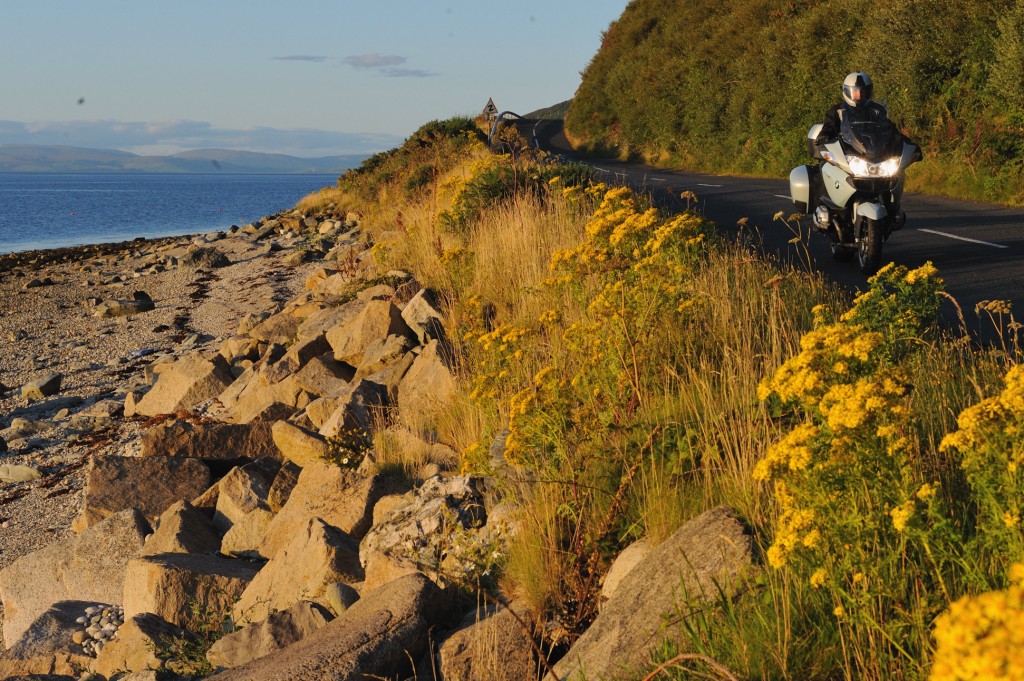
At home, in the Black Forest in southern Germany, Herbert is finally cleaning up the attic. He is deep into it when a box of old slides falls into his hands. The look on his face tells me this discovery os going to derail the cleaning efforts.
The pictures bring back memories from 1979, when he rode a Suzuki GT 550 across Scotland, with his elder sister Erika on the back. Herbert sits don on the floor and holds the slides up against the light. His eyes are gleaming with nostalgia. Finally, I realize that the attic-cleanup-session is over.
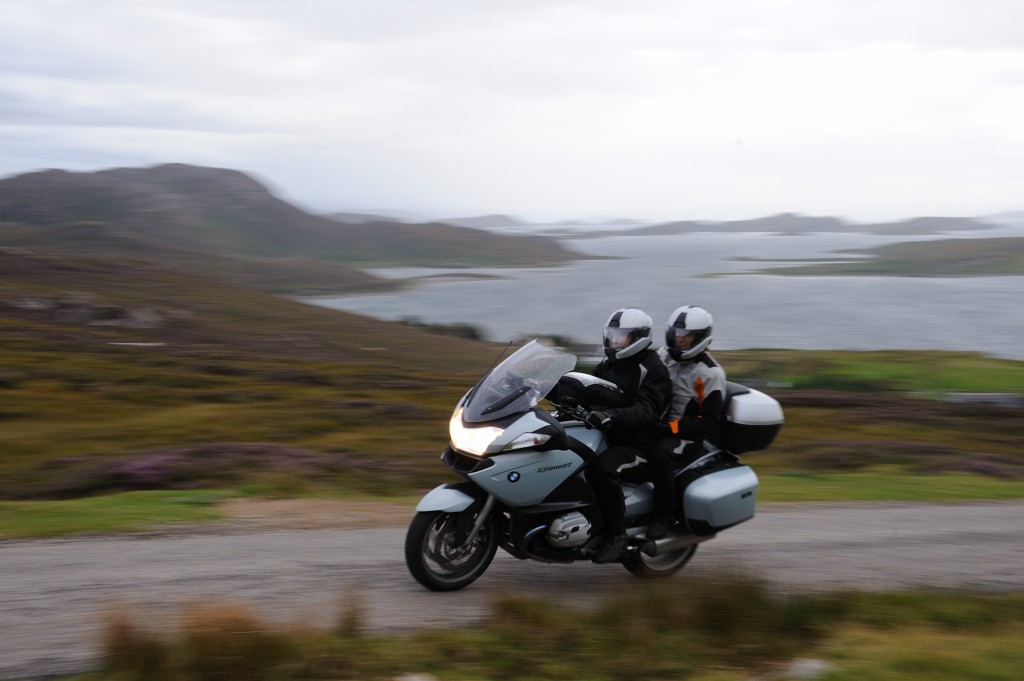
Herbert says: "That’s 30 years ago. How time flies! I need to go back." With a very convincing smile, I reply: "Scotland is new territory for me. Will you take me along?" When I think of Scotland I see myself riding on the wrong side of narrow single-track roads snaking through the remote Highlands. I can also smell the sweet scent of single malt just thinking about it.
We ponder, "What bike would be our best bet for this kind of trip?"
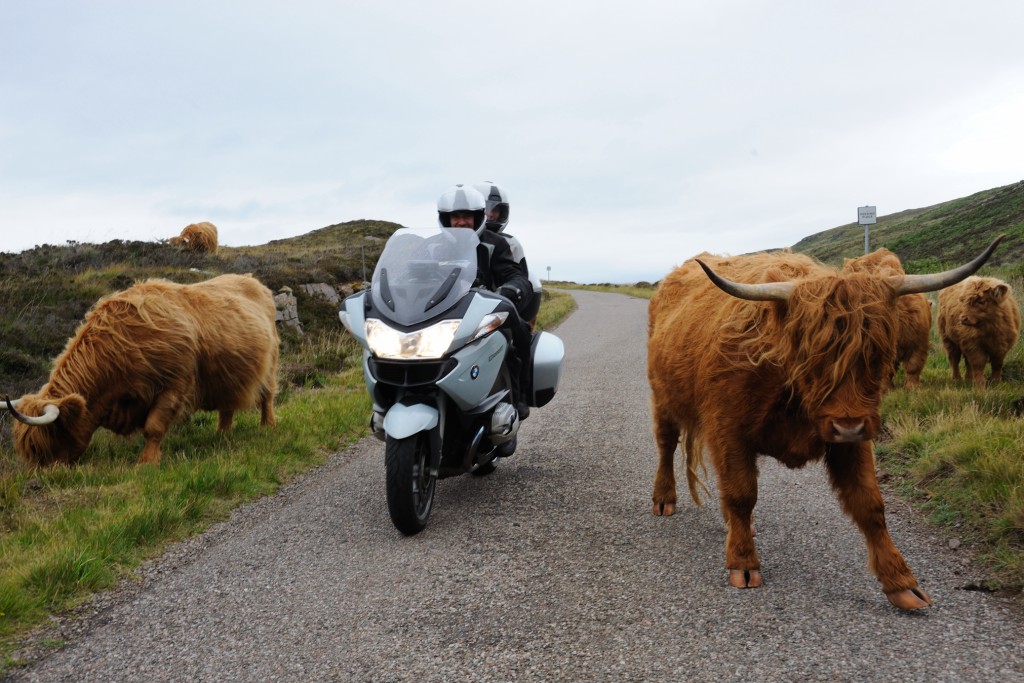
Herbert and I have explored the far-flung corners of this planet. True to the motto: Off the beaten track preferably on dirt roads, each of us on our own enduro and pitching our tent at dusk in the middle of nowhere. Scotland sounds very much like civilization and asphalt compared to our usual motorcycle adventures.
Herbert thinks out loud: "I happen to know that BMW will fit their RT with a new engine with more torque next year. It’s supposed to be sensational to ride. I’m quite curious about it. Haven’t you always wanted to travel comfortably on a bike? Getting off without a sore bum or a rumbling head, because you didn’t have good wind protection?" I slowly reply: "Sounds like a completely new experience."
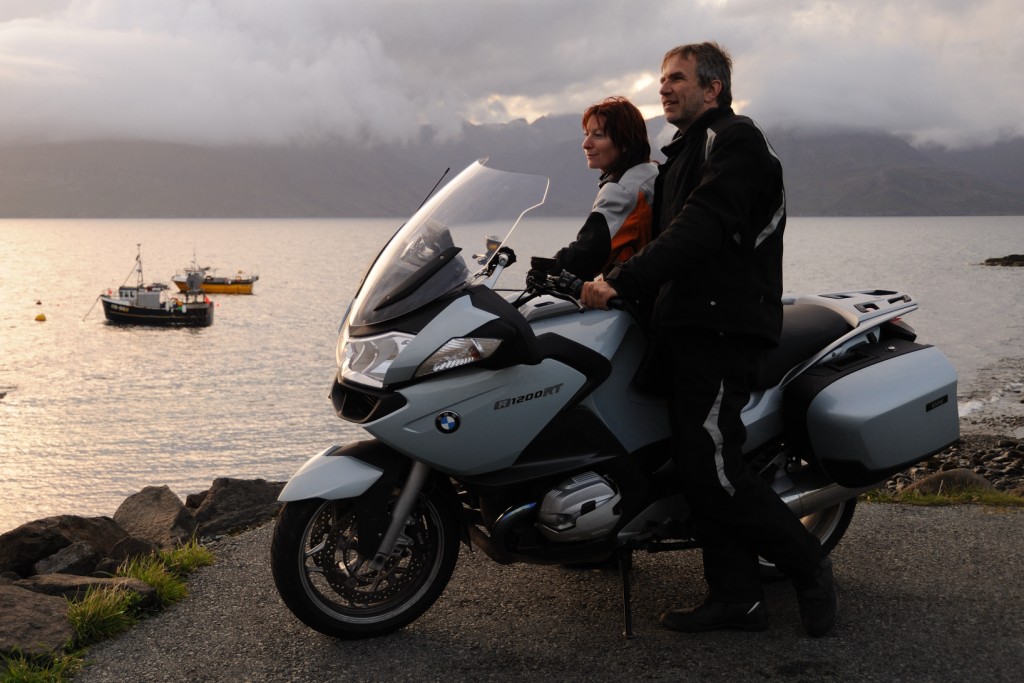
At least once per year, Herbert hears the open road calling him and heads off on a motorcycle tour. When the wanderlust sets in, its time to put new Touratech accessories to the test. The launch of a new model sets the developers’ brains working at Touratech. By the time new accessories are developed enough to be mounted onto a bike, Herbert and I have already planned out where on this planet the test is going to take place.
As soon as Herbert turns his back on Germany, the stress just melts away and the freedom of the pen roads begin to recharge his battery. The road has always been the place where he can clear his mind and find new ideas,
Both, Herbert and I are enthusiastic photographers, to the point that we fell naked without our camera We can’t imagine NOT capturing the many interesting encounters with people, the fascinating landscapes, the tough riding challenges, or simply just the moment. Motorcycle traveling is our shared passion. We usually bring back thousands of photos for a catalog story, articles and many hours of film. Many times it’s just the two of us riding, and on other trips, we are accompanies by a film team and other photographers.
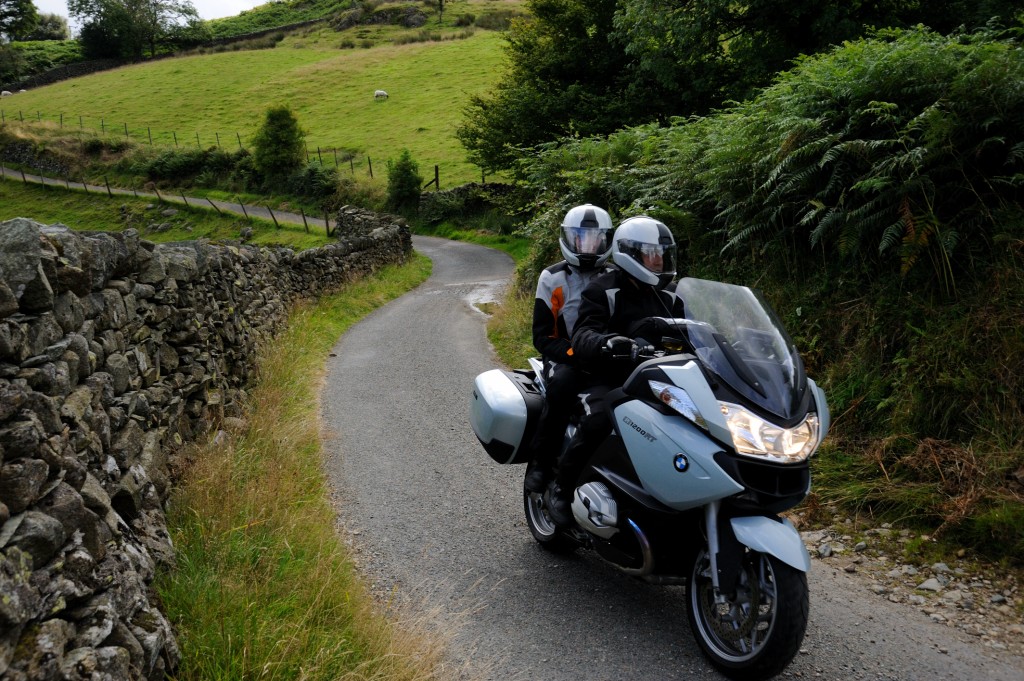
A few days and telephone calls later Herbert breaks this news to me: "BMW is going to provide us with an advances prototype of the RT for our Scotland trip. In return, we do a photo shoot for their marketing and press departments and also make a small documentary. The bike fits perfectly with our new Streetline product offering." I think to myself: "Sounds great. Where’s the catch?" Before I speak, he says: "You’ll have to ride pillion." My reply: "Why can’t we reverse the traditional roles?"
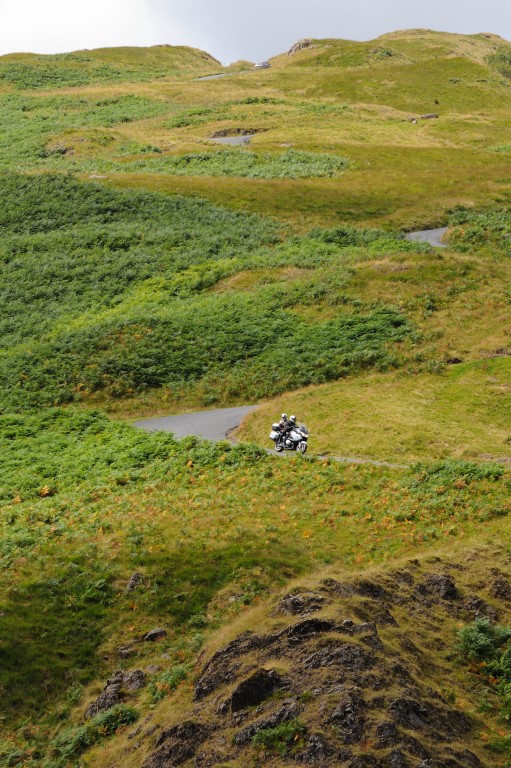
It’s not the first time Touratech and BMW Motorrad have worked closely together. It’s a symbiotic relationship with very positive results, because each is benefiting for other’s depth of experience and expertise. And it’s no different on this occasion.
In the Cumbrian Mountains
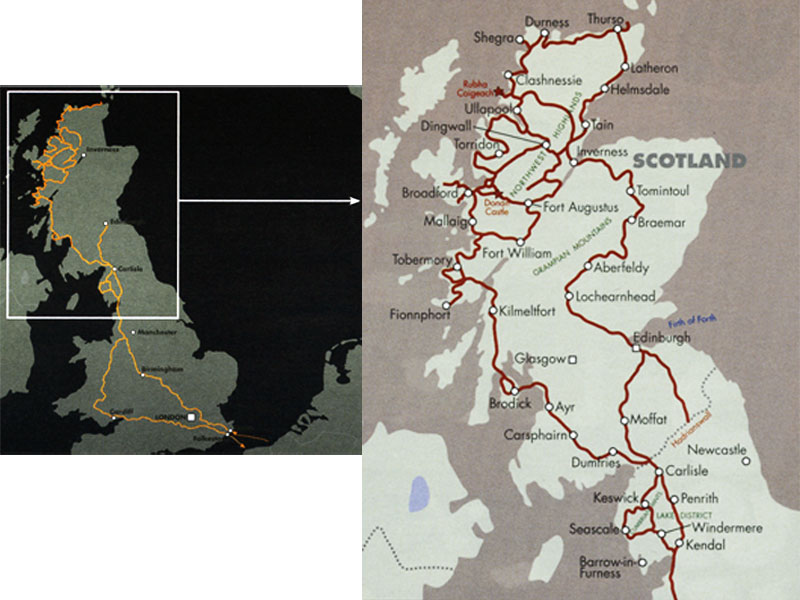
With mainland Europe in our rear-view mirrors we ride north. Mile after mile, we roll towards the Cumbrian Mountains in the north-west corner of England. They say that it’s going to take a while on a journey to arrive at your inner self. That’s true. It’s not before we are on the infamous Hardknott and Wrynose passes that we feel we become one with this country and its people. Shifting down a gear or two, literally, sounds like a good idea, for a one-in-three gradient makes the Hardknott the steepest pass road in England. The extreme curves and hairpin bends of Wrynose pass demand constant gear changing.
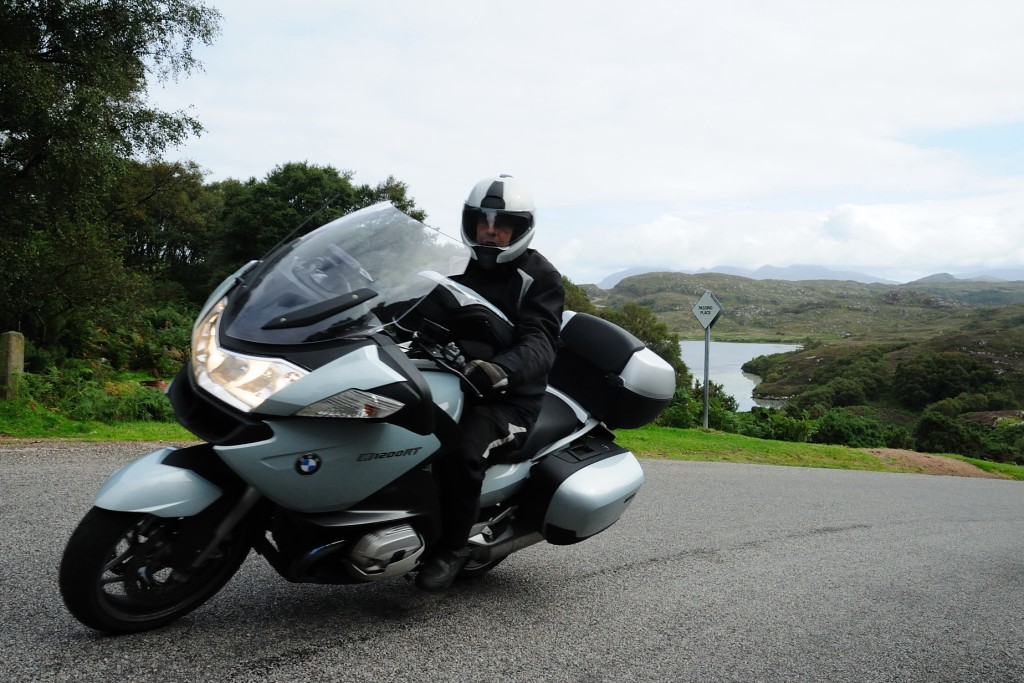
The facets of the landscape change with increasing altitude. Fleecy white sheep graze down in the valleys. The chains of hills are shrouded in mist. Patches of ferns and heather are sprinkled between mysterious moors and small, dark ponds. The chimneys of the low stone houses spout wood-smoke vertically into the milky-grey sky.
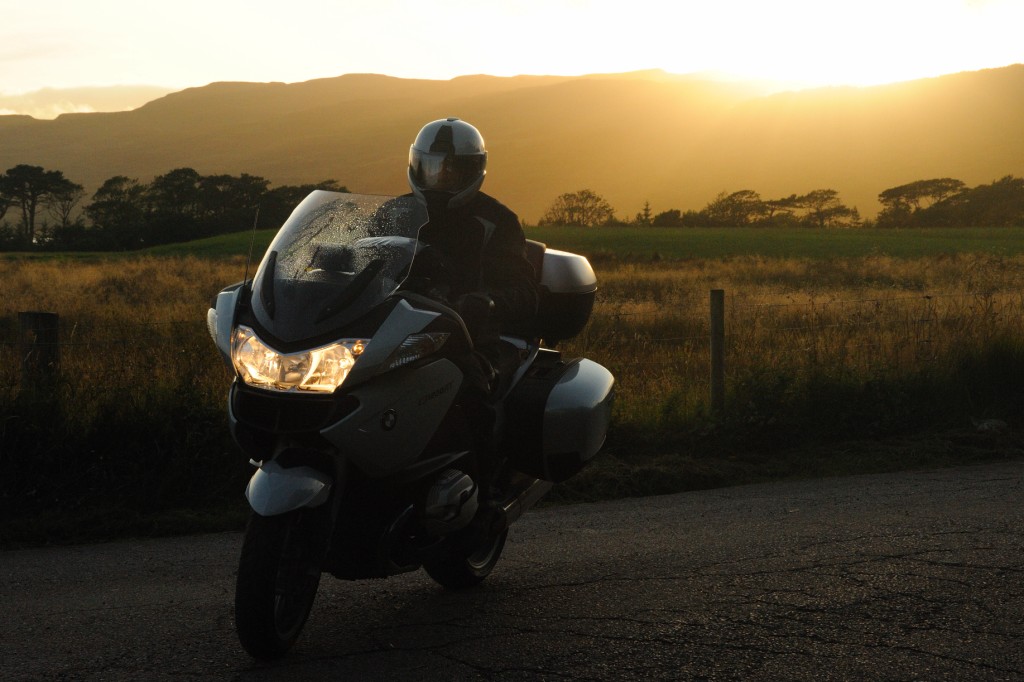
Dense oak and pine forests yield gnarly pines on barren slopes. At the top, the wind sweeps without mercy over the steep rugged rocks. With luck, one gets only two hours of sunshine a day up here. Patches of mist hang over the mystical peat land. Traces of human life are rare to find in this solitude.
Rain Thoughts
"Have you ever noticed what a sour face people put on when it rains?" a stranger once asked me. "I like rain. I surrender to it. I walk slowly through it with a smile." I felt caught. As I never wanted to have a face like a wet week anymore, I promised myself to be happy about cloudbursts to-be. It’s the moment on truth, for Scotland and rain are inseparable. It’s so green up here for a reason. Nowhere else the weather is so moody.
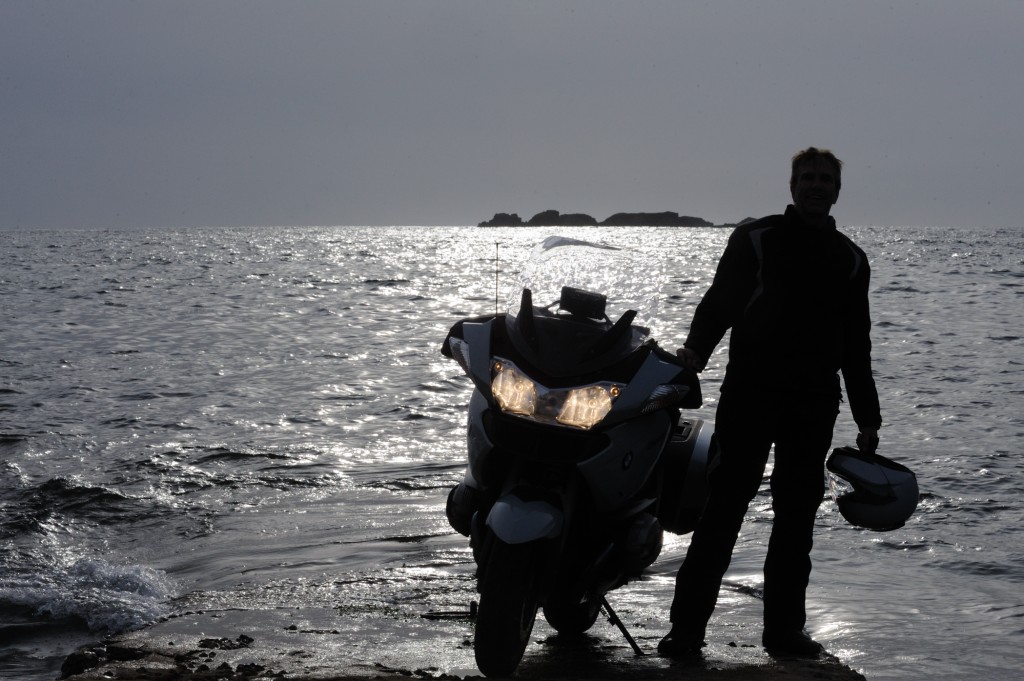
It’s good news that our Streetguard 3 suits are absolute waterproof. We feel best in them at temperatures between 10 and 20 C (50-68 F). I don’t write this to please BMW. I shudder to think of those times when I rode my enduro bike across the Bolivian Altiplano for days on end, at 4,000 to 5,000 meters altitude (about 13,000 – 16,500 ft), in the icy cold and snow. Soaked all the way through and chilled to the bone. No fun!
For Herbert rain is the equivalent of relaxation. This is when he can eventually open the throttle. In sunshine or when the light is good he has to ride back and fourth until the film footage and photos are in the can. It’s even better news that it rains much less than expected. When it does, it’s quick and hard. Actually, we are very lucky with the weather. The sun shines at least once a day, even if it’s only for three seconds.
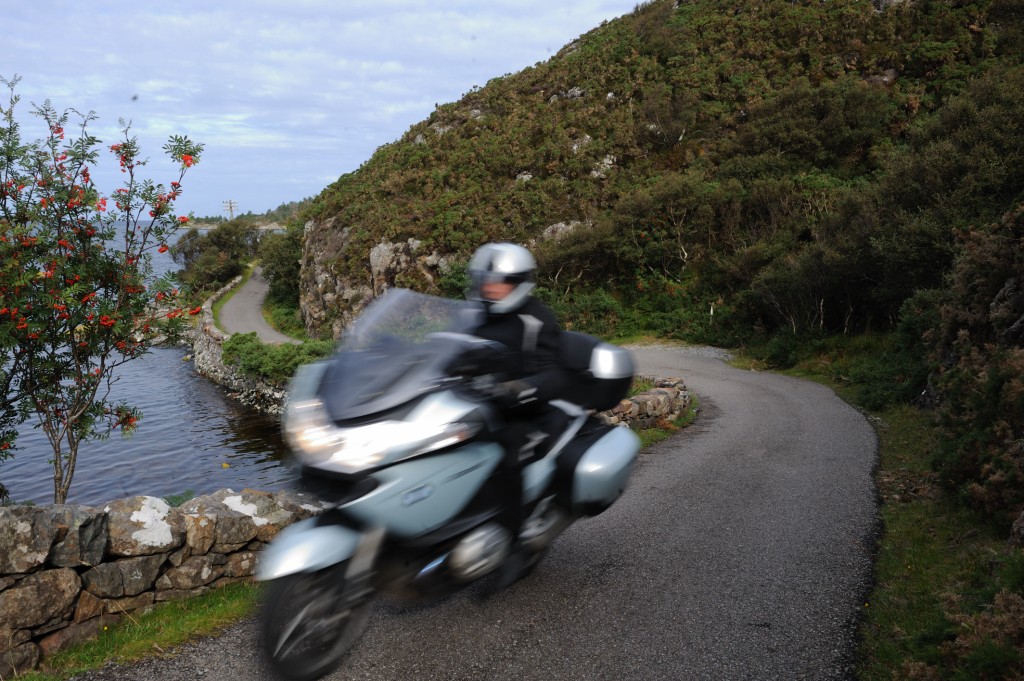
When we see dark cumulous clouds approach fast threatening our planned trip to be rained off we simply consult our map or ask the locals for alternative routes. The rain shows us the way. Like this, we become experts in island hopping and seesaw between the Scottish mainland and the small islands off the west coast. On the islands of Arran, Kintyre, Mull and Skye we act on the well-meant advice of a local lady: "When it rains you can stop more often." Why not simply make the most of it? A sign advertising "Tea and Scones" lures us out of the rain, and we gladly take the time to relax over a hot cup of tea.
The Wildest Part of Scotland – The Rugged West Coast
Among bikers, the Applecross Peninsula is considered an insider trip. It lives up to its reputation of having the most spectacular bends and the best single-track roads in Scotland. It flies by. We continue along the craggy coastline towards Durness, letting ourselves stray from the main road – if you can call it that – and follow a thin white line on the map down to the sea. Rain and sunshine play hide-and-seek with each other, and for a brief, joyous moment, a rainbow spans the dark sky.
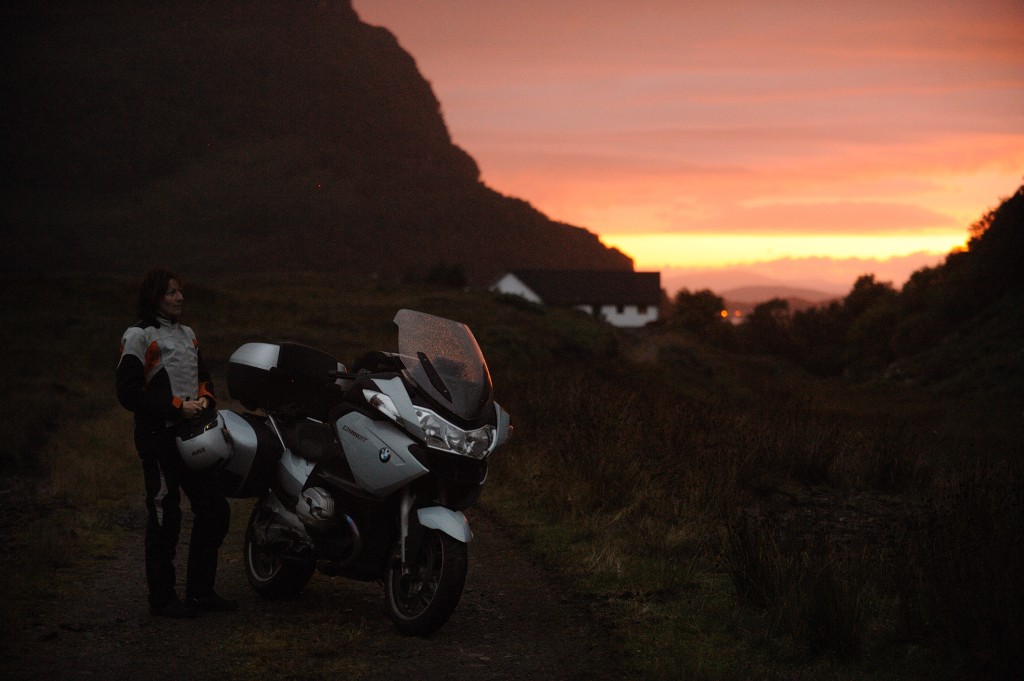
The dreaded midges, tiny bloodsucking insects attack in the thousands. "Kill one midge," goes the Scottish saying, "and a million come to the funeral." A local tells us that the only defense against them is to keep our helmets on. He is right.
Heading east. From Dunner Head, the most northerly point in Great Britain, we are southbound. Once can consider the east and the west coast of the Northern Highlands as brothers with very distinct characters. Acerb and stormy the one and gentle and well tempered the other.
Edinburgh
Inebriated by the many impressions, the curves of varied radiuses and great panoramic views (steep, wind-swept cliffs, deep fjords, sleepy little fishing villages, white sandy bays) and a shot of whiskey every now and then at night, we’ve reached the "The Auld Reekie."
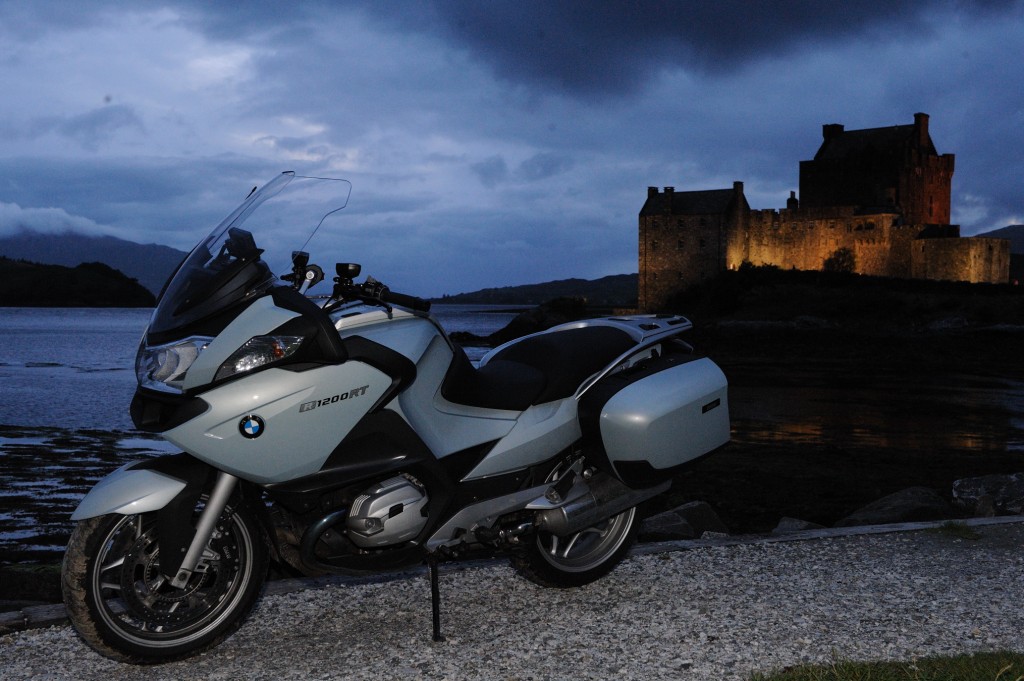
In the Dark Ages, Edinburgh resembled a stinky sewer. Anyone who was unfortunate enough to be born here didn’t have bright prospects for a good life. Thick smoke rose from the factory chimneys. The front of row houses was black with smut. The thick pall os smog forever hanging over the Scottish capital gained it the nickname "The Auld Reekie." Lacking proper sewers the excrement was piling meters high in the foul-smelling gutters. The easiest way of waste disposal was to throw it out of the window. Even corpses were disposed this way. Torture and murder were on the agenda of Edinburgh’s bloody history. The drinking water that didn’t earn this name came from a polluted lake outside.
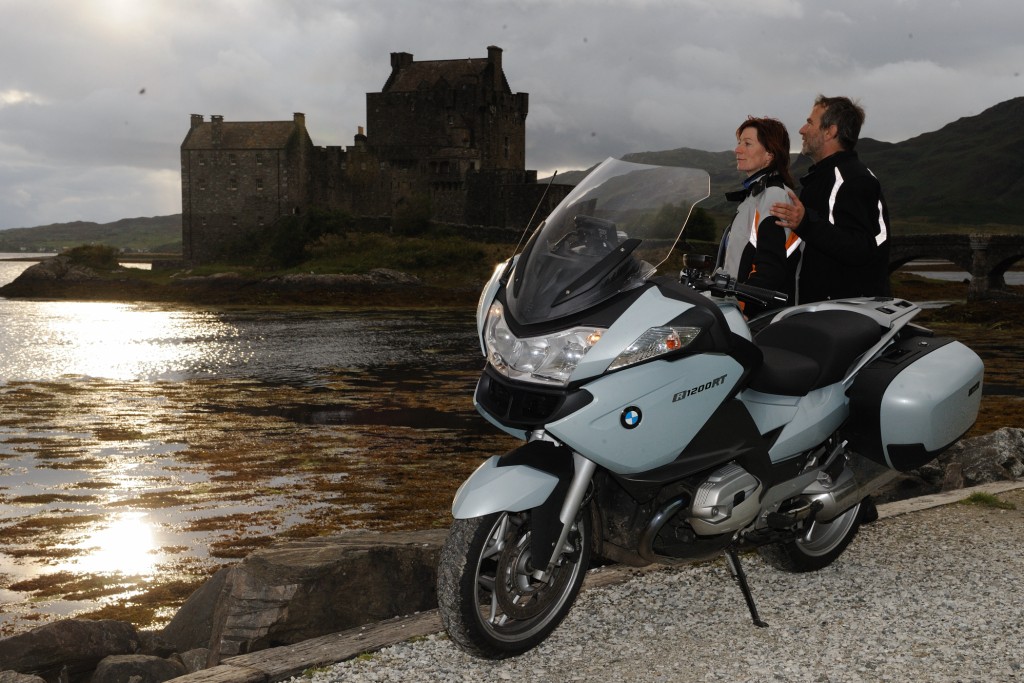
Diseases spread rapidly on these unhygenic conditions. In 1645, the plague broke out in the overcrowded city. Space was so scarce that people dug narrow channels underground the houses of the old town. No ray of light would reach these pitch-dark unventilated vaults. The poorest of the poor, the faceless and nameless, vegetated in the so-called closes. Nobody would even notice if they disappeared. Mary King’s Close was named after a prominent businesswoman in the 1630’s. It lies 13 meters (43 feet) underneath the cobble-stones. The city fathers believed that the Back Death had come from the darkness of this catacomb. Without asking any questions they ordered to wall the channel up on both ends – including the people who lived there. Their poor souls are said to be still restless wandering around.
But that’s all history. To feel the pulse of today’s Edinburgh we explore the famous Royal Mile by foot. Jugglers, street musicians, and acrobats perform on what seems to be a parlor and a stage at the same time. Edinburgh Castle sits 115 meters (377 feet) high atop a rocky cliff on the upper end of the Royal Mile. 1.2 million visitors a year marvel at the precious Scottish crown jewels.
Old Town and New Town are a tantalizing contrast. Perched on a hilltop, the historic town, with labyrinthine cobblestone alleys, narrow courts and 500-year-old "skyscrapers" with up to 12 stories, looks down onto the modern Edinburgh.
We’ve travelled 3,045 miles and the road home is calling. A jam sessions at Sandy Bell’s, a typical pub with a good atmosphere packed with people and lively conversations in full flow at the bar, is the perfect place to click glasses "to a good trip" or better yet, "pure dead brilliant," as the Scots say.
Facts and Information
In General:
It’s typical for Scotland to have four seasons on one day. The best time to travel here is between May and September. Gently rolling green hills characterize the landscape in the south and east. The west coast of the Highlands is wild, with deep fjords, everglades, dark lochs, and rugged mountains.
How to Get There:
From Europe, the choice is between a 35-minute train-ride through the Channel Tunnel or a 1.5-hour ferry ride from Calais (France) to Dover (England). From there, it’s another 470 miles on the road to Edinburgh. The alternative is the 15-hour night ferry from Amsterdam (Netherlands) to Newcastle (England).
Food & Lodging:
Scottish food is simple and nutritious. Specialties include porridge, black pudding (blood sausage), haggis, cullen skink (a fish soup with smoked haddock), tea and scones.
Accommodations are more difficult to find in the remote Highlands. B&B are very popular, but be sure to make reservations in the summer. Camping is also available, but requires weatherproof equipment and it can get cold.
Road & Biking:
Riding on the left takes less time to adjust than most people think. Plus traffic in the Highlands is reduced. Nevertheless, there’s always the danger of lapsing into old habits, like pulling out into traffic in the wrong lane after turning. Put a reminder note in your cockpit to ride on the left.
Road quality ranges from excellent to catastrophic. Single-track roads are narrow and curvy and lots of fun for experienced riders. Mind the loose animals on the road (sheet and Highland cattle). Also, whenever you get the chance to gas up in the Highlands, take advantage as the next gas station could be quite far.
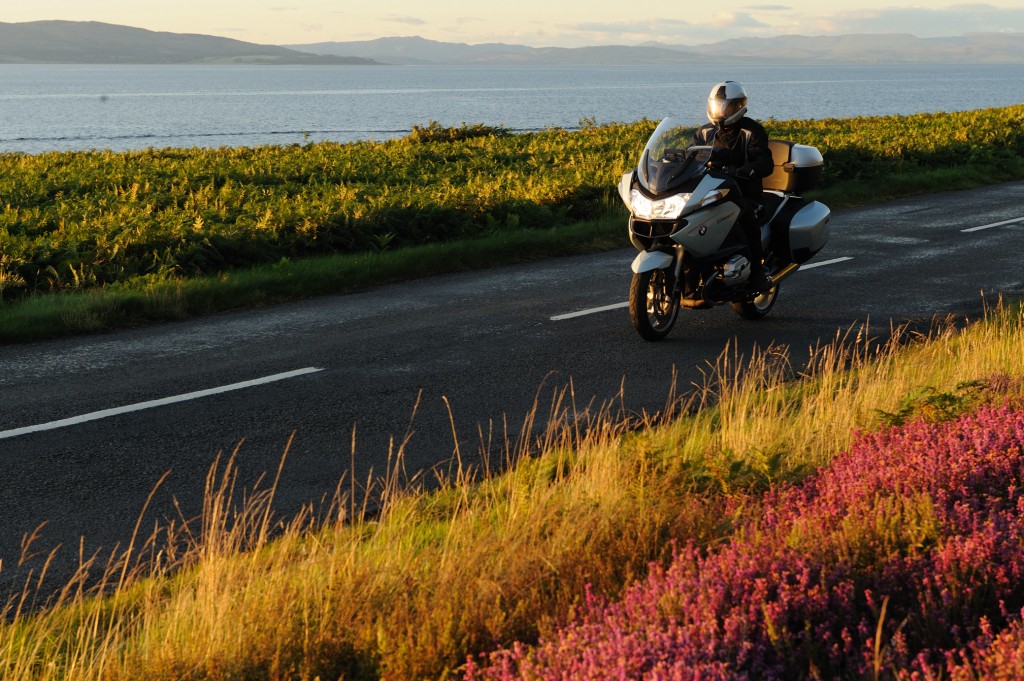
Books & Maps:
Scotland Country Guide by Neil Wilson, Lonely Planet, ISBN 978-1741047257, $22.99
Western Scotland and the Western Isles, Ordnance Survey, ISBN 978-0319240601, $8.26
Northern Scotland, Orkney and Shetland, Ordnance Survey, ISBN 978-0319240595, $8.26
Southern Scotland and Northumberland, Ordnance Survey, ISBN 978-0319240618, $8.26
Garmin Map Source Europe
Text by: Ramona Schwarz
Photography by: Ramona Schwarz, Herbert Schwarz and Violetta Bismor